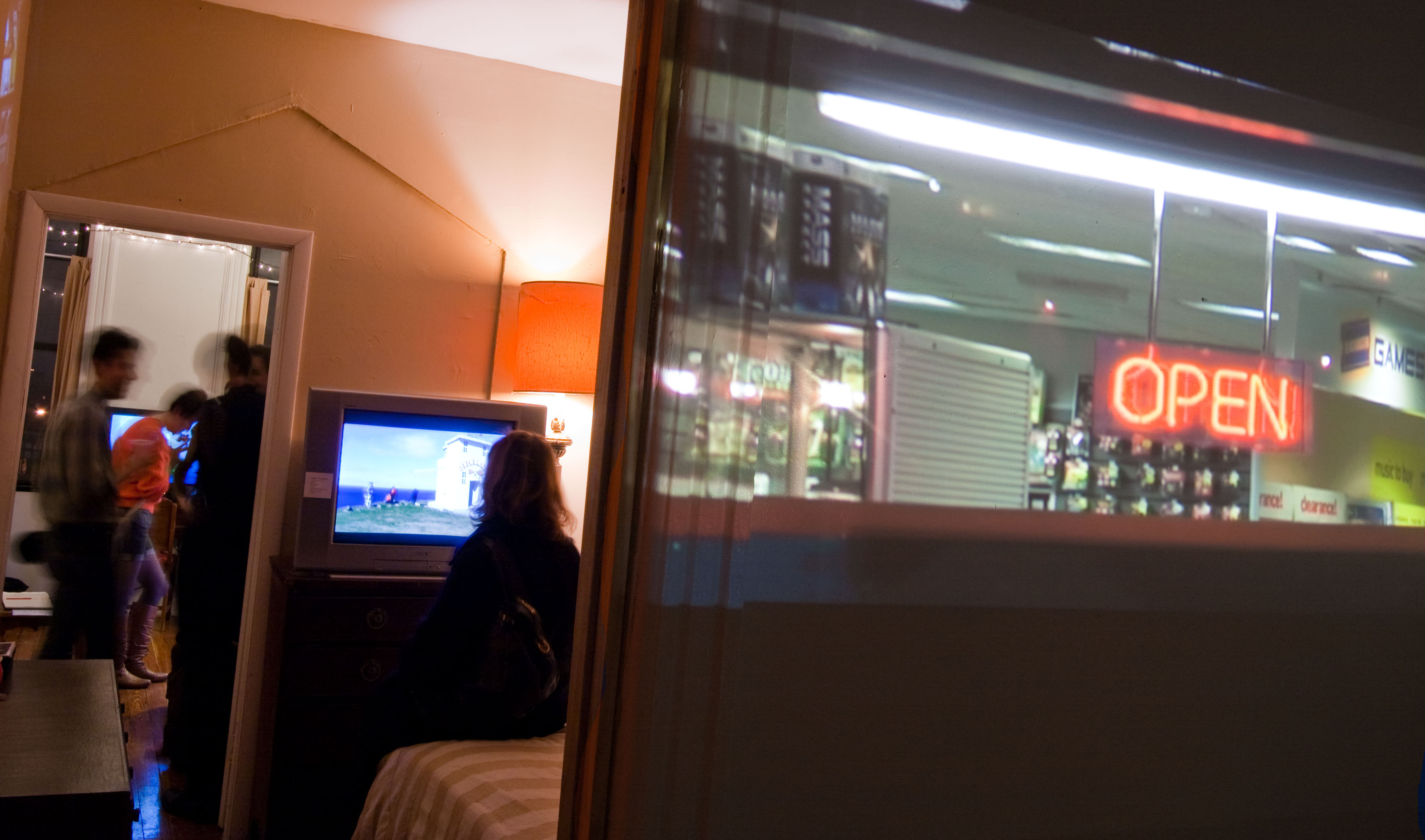950 hart gallery
neighborhood: bushwick | space type: art gallery | active: 2010–2012 | links: website, blog, facebook, twitter
950 Hart came relatively late to the Bushwick gallery scene, but they were incredibly busy. In their first nine months, they put on seven shows in their space, plus one off-site at Life Café. The gallery spanned two floors, with the basement holding their permanent collection, featuring work from three of the space’s four founders: Michael Kronenberg, Antoinette Johnson, and Mikki Nylund. Sean Alday, the fourth member of the team, is a writer, blogger, videographer, and unofficial gallery historian. When I went to the opening of “A Midsummer Night’s Dream,” it was pleasantly busy, and several of the artists were there to talk about their work. Everyone I met was welcoming and warm, and eager to share their excitement about the project.
Due to skyrocketing rents in the neighborhood, 950 Hart closed their doors in July 2012, along with several other pioneering Bushwick galleries, including Famous Accountants and Botanic.
Q&A with Michael and Sean
brooklyn spaces: Do either of you have any prior curating experience?
Sean: All I’ve really done is construction and gardening; I learned how to make things lovely through construction, and then with gardening I learned how to put things in the right order. I did a lot of Zen gardening, so my first curating experience was making a little garden on the side of a hill. Then I got here, and I realized it’s another little garden on a hill, and it just needed to be cultivated.
Michael: Sean’s being modest; he’s actually been a godsend. He’s incredibly brilliant and very motivated, and super at coordinating and reaching out to people. He also has a really good idea of what he wants to do and a great eye for new talent.
brooklyn spaces: What made you decide to start a gallery?
Michael: We’re acquainted with a pretty large circle of creative, talented artists, and we wanted to try to get more exposure for them. We started talking about starting a gallery when we were all hanging out. Mikki and I were making art, and Sean was writing and video-documenting everything.
Sean: And Antoinette went out and got four panels and started meticulously crafting the checkerboard pieces that are now in the permanent collection. She worked on the piece for about a month straight. Every time I came by, she was working on it. It’s a very good vindication of the enthusiasm we had about doing this, and it kind of became the reason we were doing it, because everyone was so excited about it. And we all fed off of the excitement; there was no way not to.
Michael: I also want to give a big shout-out too to Grant Stoops, from Bushwick Project for the Arts. He’s the one who talked me into actually showing my stuff for the first time, and now we’ve got some of his pieces in our permanent collection, too. It’s great synergy.
brooklyn spaces: Who are some of your favorite artists you’ve shown?
Sean: We love all of our artists, but some who come to mind are Raquel Echanique, Teddi I Rogers, Eisig Frost, Irena Romendik, E.V. Svetova, Sandee Pawan, Worm Carnevale, Jarvis Earnshaw, and Dan Victor.
brooklyn spaces: Tell me about some of the different shows.
Sean: The first show was called “950 Hart,” and just putting it up was big for us. The second one, “Broken Hearts,” was even more exciting, and the responses from both of them were so different that it pushed us to do the third show, “The Garden of Eve.” For that one, we wanted something that was going to push us to be more creative than we had been, and also be unique enough that it would draw more artists and more people who appreciate art spaces.
brooklyn spaces: Do you prefer a certain type of art?
Michael: We like to encourage figurative and abstract art to a certain extent. We like to give enough of a leading narrative so that people can either take it and run with it or reflect back or come in with something completely off in left field. But as far as a criterion for what we show, if we respond to it emotionally, we show it. It doesn’t matter what your name is. We’re not particularly interested in pedigrees; we look for people who are sincere and generate an emotional response from the viewer. We’re looking for positive, energetic, upbeat pieces that are made in Brooklyn—and certain other places as well, as the octopus spreads out his tentacles.
 brooklyn spaces: Are you a part of the greater Bushwick art scene?
brooklyn spaces: Are you a part of the greater Bushwick art scene?
Michael: Yes. This year we did a show for Bushwick Open Studios, which allowed us to interact more with the community, and let them know we’re here. We had a really good response from the organizers; they were so supportive.
Sean: After that, we did a show at Life Café. Actually, we put up three different shows over the course of a month, framed as art battles.
brooklyn spaces: What are your goals for the future of the space?
Michael: To have as many shows as possible, and to eventually expand outward and upward.
Sean: For me, the main thing is progressing the community. We want to leave behind a roadmap for the kids who come after us, because eventually there’s going to be curiosity about what happened here in Bushwick. That’s why I’m videoing everything and blogging as much as I can about what we’re doing. It’s an easy way to feel like you’re doing something for the community of the future.
***
Like this? Read about more art galleries: Ugly Art Room, Wondering Around Wandering, Concrete Utopia, See.Me, Central Booking, Micro Museum, Invisible Dog








 Central Booking is the curatorial vision of
Central Booking is the curatorial vision of 



























